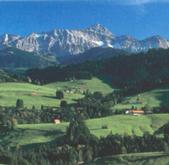CS 2001 "Appenzell Ausserrhoden 1: Sustainable landscape development"

The sustainable development of landscape and its scientific analysis represent both a complex ill-defined wicked problem. Such complex object can only be mastered and designed, if knowledge and experience from science and society are combined.
The canton of Appenzell Ausserrhoden is an example of a rural area being located in the immediate vicinity of the sub-centre of St. Gallen and at the remote periphery of the principal centre of Zurich. The communities at large distance from the inter-regional traffic infrastructure and the centres suffer from decreasing population, decreasing labour opportunities, and thus decreasing wealth.
The growing market demand for organic agriculture can be considered as a supporting asset. Touristic impulse projects can initiate important multiplication effects. Well designed improvement of the appearance of the villages is as important as the preparation of touristic infrastructure. Cooperation between business and administrations and especially alliances between communities are necessary to create synergies. Optimising the environment is an absolute must to fight against the existing threats.
Characteristics
- Case: Area of 242 km2, 50,000 inhabitants
- Co-operation: Canton Appenzell Ausserrhoden
- Duration: Preparation from Autumn 2000 to October 2001, Student's work from October 2001 to January 2002, Book Production from February to September 2002
People
- Headship: Prof. Dr Roland W. Scholz (ETH), Michael Stauffacher (ETH), Dr. Hans Altherr (Case)
- Administration: Sandro Bösch (ETH), Werner Liechtenhan (Case)
- Tutors: Stefan Déer (Regional Secretriat AR), Martin Fritsch (ETH), Anna Hersperger (ETH), Andreas Hofer (External), Werner Liechtenhan (Regional Secretariat AR), Robert Meier (External), Dr Raimund Rodewald (External), Andres Scholl (Regional Planning AR), Prof. Dr Roland W. Scholz (ETH Zurich), Christoph Schreyer (External), Dominik Siegrist (External), Michael Stauffacher (ETH), Alfred Stricker (Case), Arnim Wiek (ETH)
- Steering Board: Prof. Dr Roland W. Scholz (Head, ETH), Dr Hans Altherr (Head, Appenzell Ausserrhoden AR), Ruedi Aerni (Business Development AR), Daniel Berger (Agriculture & Forestry AR), Hans Buderer (Environmental Protection Office AR), Stefan Déer (Regional Secretriat AR), Werner Liechtenhan (Regional Secretariat AR), Robert Meier (External), Andres Scholl (Regional Planning AR), Michael Stauffacher (ETH), Alfred Stricker (Farmer Stein), Peter Witschi (Public Record Office AR)
- Students: 38 ETH Students
Products
Case Study Book
- Scholz, R.W., Stauffacher, M., Bösch, S. & Wiek, A. (Eds.) (2002). Landschaftsnutzung für die Zukunft – Der Fall Appenzell Ausserrhoden. ETH-UNS Fallstudie 2001. Rüegger Verlag, Zürich. ISBN 3 7253 0733 4. DownloadDownload (PDF, 66.1 MB)vertical_align_bottom
Scientific Articles
- Scholz, R. W., Binder C.R., Lang, D.J., Smieszek, T. & Stauffacher, M. (2011). Applying the HES-framework. In: Scholz, R.W.: Environmental Literacy in Science and Society: From Knowledge to Decisions. Cambridge: Cambridge University Press (pp 453-462).
- Seidl, R., Brand, F. S., Stauffacher, M., et al. (2013). Science with Society in the Anthropocene. Ambio, 42(1), 5-12. DOI: 10.1007/s13280-012-0363-5
- Stauffacher, M., Flüeler, T., Krütli, P., & Scholz, R. W. (2008). Analytic and dynamic approach to collaborative landscape planning: a transdisciplinary case study in a Swiss pre-alpine region. Systemic Practice and Action Research, 21(6), 409-422
- Wiek, A., Binder, C.R. & Scholz, R.W. (2006). Functions of scenarios in transition processes. Futures, 38, 740–766.
